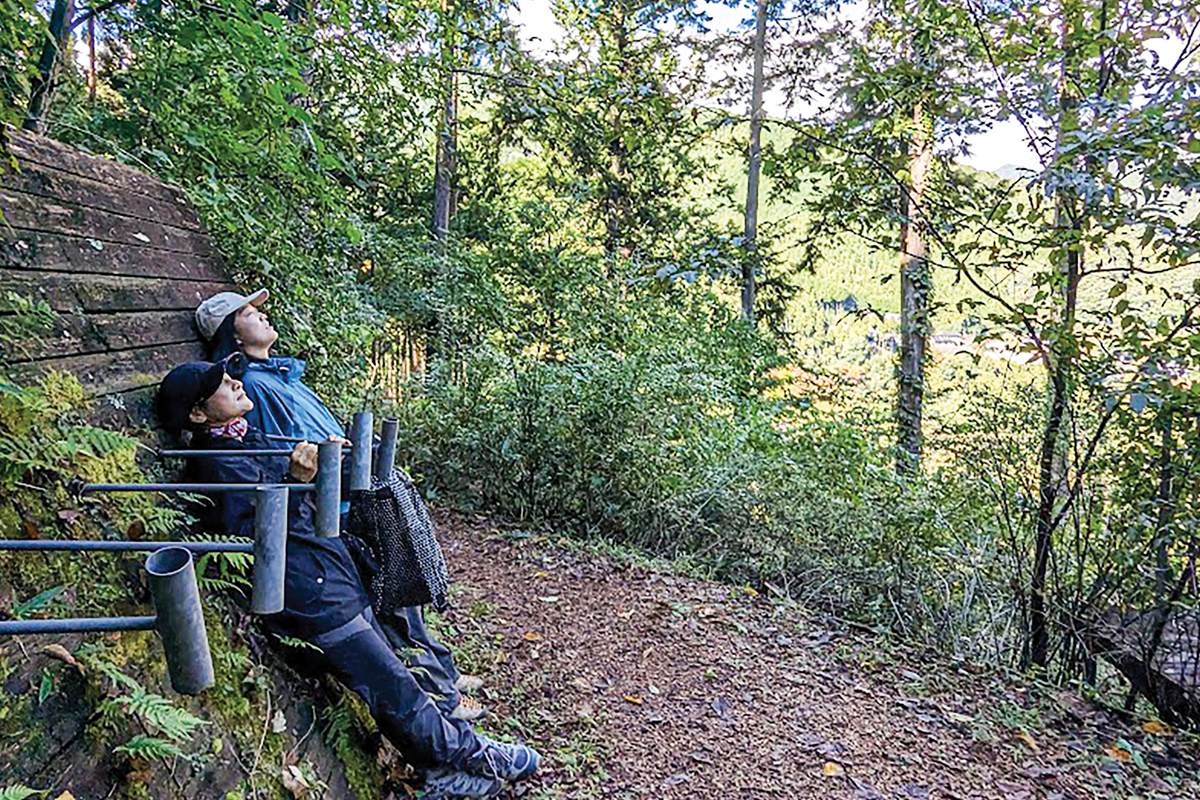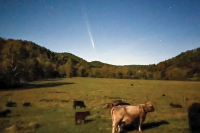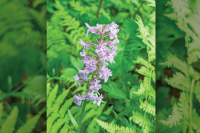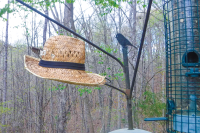Feeling the forest: Forest therapy offers opportunity for restoration
 Forest therapy trails in Japan often have various structures like this one that support the forest bathing experience. Mark Ellison photo
Forest therapy trails in Japan often have various structures like this one that support the forest bathing experience. Mark Ellison photo
With my eyes closed, I can’t see the patchwork of brown leaves and fallen twigs covering the forest floor before me, the pale green lattice of lichen peppering the trunks of upward-reaching trees, or the waters of Fisher Creek rushing over a bed of weathered rocks.
But I can feel where I am. A light breeze teases my right cheek, the cool air not quite masking the scent of decaying leaves and bright mountain water.
“Notice the variety of sounds,” says Mark Ellison, a certified forest therapy guide, as he stands a short distance away. “The distances — near, far. And patterns. Try to find the rhythms in the sounds around us and how they interact with each other.”
I listen, noting how the creek’s upstream rumble plays against the higher-pitched crystal of the rivulet in front of me, a musical track that continues into infinity.
Ellison continues, speaking slowly through a 10-minute invitation that offers an opportunity for each of the senses to experience this familiar piece of trail as though it is brand new.
“What did you notice?” Ellison asks as I open my eyes — restored, refreshed, and grateful for this moment within an otherwise harried day to do nothing but simply be part of creation.
Related Items
Slowing down
Normally, this exercise would be just one portion of a two-hour experience Ellison offers at Pinnacle Park in Sylva, which is home to one of the globe’s 20 certified forest therapy trails. Today, he’s offering a taste of a tool that’s fascinated him since he first learned about it in the early 2000s, while researching his Ph.D. in adult education and human resource development.
“Forest therapy is about slowing down,” he said. “It’s not about covering a distance or about exercising. Conversely, it’s about disconnecting and stopping, and just being able to notice with all your senses everything that’s around you.”
Forest therapy, which originated as shinrin-yoku, or “forest bathing,” in Japan in the 1980s, is still fairly young in the United States. When Ellison began leading walks in 2012, it was nearly unheard of. But the idea connected with something he’d learned about himself back in the late 1980s as a student at Western Carolina University. Ellison had never hiked much before enrolling at WCU, when he started taking solo walks in the woods.

A member of an October 2023 forest therapy tour in which Mark Ellison participated gestures toward a scenic view in Japan. Mark Ellison photo
“I just enjoyed the way I felt when I went out in nature that way,” he said. “But I also noticed, when I came back, I was able to think more clearly. I was better able to focus. And then my grades started improving.”
Research supports Ellison’s anecdotal experience. According to Harvard Health Publishing, a walk in the forest has been shown to decrease levels of the stress hormone cortisol. Other research has shown an increase in the number of immune cells among people who spent three days and two nights in a forest, and improved self-reported health and well-being among people who spend at least two hours each week in nature.
Gaining steam
When Ellison first stumbled across the concept of forest therapy as a student at N.C. State, it was a concept without name recognition in the United States. A 2014 article in Oprah Magazine helped change that, and since then it’s continued to gain traction.
“I think it’s very much taking off,” Ellison said, comparing its trajectory to that of yoga, which began gaining popularity in the United States in the 1970s. Today, it’s mainstream —many people do it, and most people have at least heard of it.

Mark Ellison has been leading forest therapy walks since 2012. Holly Kays photo
In recent years, forest therapy has garnered increasing levels of interest and recognition. A quick Google search pulls up articles from publications such as National Geographic, The LA Times and CBS News.
“I think it’s going to continue to [grow] as people are looking to find ways to maintain mental health,” Ellison said. “This is a great way to disconnect from the things that can bother us now. Getting away from being on the internet all the time, getting away from all the noise, getting away from all the distractions and being able to connect with things are nurturing to us.”
Ellison has been involved with the U.S. forest therapy movement since its inception, collaborating with Association of Nature and Forest Therapy Founder Amos Clifford as well as “The Nature Fix” author Florence Williams within his first year or so of leading walks. By 2022, he’d worked with the Town of Sylva to get the half-mile trail at the bottom of Pinnacle Park certified as an official forest therapy trail — one of only 20 such trails worldwide.
The Pinnacle Park trail offers self-guided options to reap the benefits of forest bathing, in the form of paper brochures and a QR code at the trailhead. Visitors are encouraged to practice sensory awareness through both stillness and taking a slow and purposeful walk. They’re asked to find a tree that draws them in, find a spot to sit and be present and touch the waters of Fisher Creek.

Fisher Creek cascades along the Forest Therapy Trail at Pinnacle Park. Holly Kays photo
But for those seeking a more intensive experience, there’s the guided option. Many people who hire Ellison to lead them through have undergone some kind of trauma.
“I’ve had several families come out as a way to remember someone who’s passed,” he said. “A woman who came out here as a way to remember her husband who loved nature. This was a way for her to feel connected to him. A mother who lost her son, and another mother who’d lost her daughter. They felt like this was a way they could reconnect and remember them.”

Ellison prepares a tea ceremony featuring white pine tea on the forest therapy trail at Pinnacle Park. Holly Kays photo
In October 2023, Ellison was one of about 20 forest therapy guides to join the first-ever tour of shinrin-yoku trails in Japan, a joint event of the U.S.-based Association of Nature and Forest Therapy and Japan-based Future with Forest.
“That was one of the best experiences of my life,” Ellison said.
He elaborated on that sentiment in a blog post describing the trip.
“There was so much about this experience that pushed my edges, challenged my thinking, opened my eyes,” he wrote. “It changed me. I was expecting that visiting the forest therapy trails would be impactful, but more so it was the people … Returning home I visited one of my favorite trails to hike. I was noticing things I had not in a long time. Things seemed different in a place I have been hundreds of times. The journey recharged, inspired and touched me in a way that has not happened in a very long time.”













